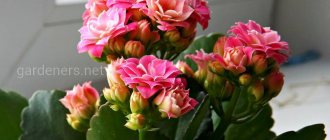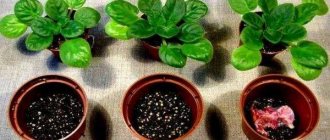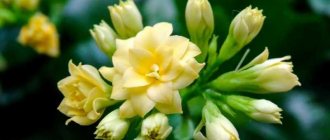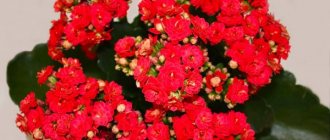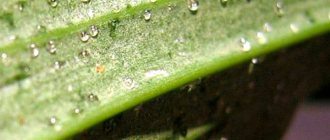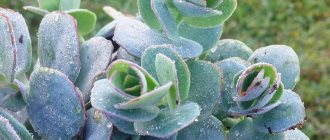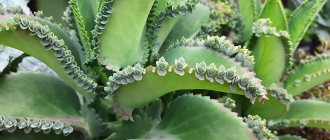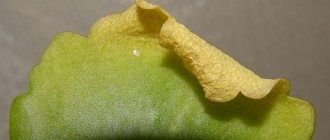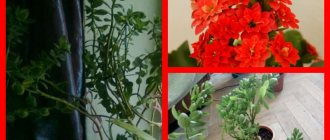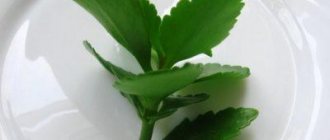Kalanchoe Kalandiva is a miniature plant that is covered with bright double flowers for several months of the year. For this reason it is also called a “flowerbed in a pot.” According to botanist D. D. Hessayon, Kalandiva is the best-selling houseplant. Unfortunately, many people buy Kalanchoe on the spur of the moment, and after flowering ends, they throw the bush away. And in vain, by adhering to simple rules of care, you can ensure that Kalandiva grown at home will delight the owner with its beauty all year round.
Characteristics and description
Kalandiva is a very tenacious and undemanding plant, like other species.
Its main advantage is lush flowering for a long time.
If conditions are favorable, it can last six months.
Another feature is that it blooms in winter , often blooming on New Year's Eve.
As
a succulent, it has thick, rounded stems densely covered with fleshy leaves.
The shoots are numerous, branch well and produce aerial roots. The leaf blades are painted in a thick dark green color, their surface is leathery and glossy. The shape is round or ovoid, the edges are cut into small, frequent teeth.
The inflorescences are double , located on a short peduncle, folded into lush umbrellas.
The color is quite varied, including pink, orange, purple, red, yellow and beige shades.
Mix is a descendant of Kalandiva mini , its hybrid. The main difference from the parent is that flowering can continue without interruption all year . There are no special care requirements.
Table: Brown spots on leaves, the appearance of insects, and so on - ailments and pests
| Signs | Cause | Treatment | Prevention |
| Elongated stems, pale and small leaves | Excessive watering and lack of light | Move to a sunnier place, stop watering until the soil dries completely. | Follow the rules of watering and daylight hours. |
| Dry brown spots, falling leaves | Lack of moisture | Increase the frequency of watering. | Do not forget to water the plant immediately after the earthen clod dries. |
| Drying and curling leaves, on the reverse side of which small green or white insects are found | Aphid | Treat Kalanchoe with a biological (laundry soap solution - 1 gram per liter of water) or a chemical preparation (Aktara, Agravertin, etc.). | Remove dead leaves in a timely manner and regularly inspect the Kalanchoe. |
| Weeping brown spots on leaves | Viral or bacterial infection | Remove the affected leaves and treat the plant with a fungicide (for example, Trichodermin). | Remove dead parts of Kalandiva. |
Photo
Problems in growing
With insufficient care, pests have a negative effect on the flowering and decorative properties of the plant. Possible problems:
- Rot. The reason is the strong moisture of the earth and the low temperature in the room. Replanting into new soil, pruning damaged shoots, treating cut areas with activated carbon, and reducing watering are required.
- Brown areas on leaves. The problem occurs when there is a lack of watering and the plant is depleted. An increase in moisture volume is required.
- Yellow leaf coating occurs when there is insufficient sun light. Place the container in a lighted place and use a phytolamp.
- Black spots on foliage are a symptom of a fungal infection. A one-time treatment with an antifungal agent and transplantation into disinfected new soil are required.
- Wrinkled leaves indicate low humidity and lack of watering. Kalandiva needs to be sprayed with a spray bottle. It is also necessary to increase the volume of moisture.
- The appearance of a whitish coating is associated with powdery mildew. Bordeaux mixture or Oxychom will help eliminate the disease.
- Aphids are removed with a solution of laundry soap.
Thanks to timely disposal of the problem, the flower will continue to develop. Careful care of Kalanchoe Kalandiva will allow you to enjoy the beauty of the plant for a long time.
Care
Temperature
Regular room temperature between 22-27° is quite suitable for Kalandiva.
It tolerates short-term temperature drops of up to 6-9° and any heat, up to 40°.
Light mode
If you want to achieve long-term flowering, place the African guest on a south window.
Kalandiva loves light very much and is not afraid of direct rays of the sun.
Being on the eastern and western sides of the house, it does not form inflorescences.
In addition, the shoots will begin to stretch and thin, the leaves will be located far from each other, greatly exposing the stem. Kalandiva will completely lose its attractive appearance.
Watering
As a succulent , it does not tolerate frequent watering and plenty of water.
Constant soil moisture will provoke an attack of fungal diseases , causing rotting of the roots and stems. Drought will harm the plant much less, so do not overwater the plant.
It is quite enough to moisten the soil every 6-8 days, even in summer. In any case, you need to wait for the soil on top to dry.
Immediately after watering, the water that has leaked into the pan must be poured out. Experienced flower growers even recommend wiping dry both the bottom of the pot and the tray.
For irrigation, use only softened water with a minimum amount of lime.
To do this, tap water must be settled or boiled, or melt and rain water must be used. Otherwise, a coating will form on the surface of the earth, which will prevent the passage of air to the roots.
If kept in a cool room in winter, watering is further reduced, increasing the interval between procedures by 5-7 days.
Don't worry - it won't hurt him. But excess moisture will almost certainly cause rotting of the roots and base of the stems.
Humidity
Kalandiva does not need high humidity.
Do not spray it or place a container of water next to it. It is quite enough to occasionally wipe the leaves from dust or take a cool shower for the same purpose.
Dust clogs the stomata through which the plant collects moisture and interferes with its normal development.
Top dressing
The most necessary fertilizers, especially during flowering, are potassium and phosphorus. They should be applied regularly - individually or in combination.
The interval between feedings is standard - from 10 to 15 days.
But fertilizing with organic matter or not use it at all, since it contains a lot of nitrogen.
This substance causes the flower to fatten, it begins to intensively grow green leaves and shoots, and forgets about flowering.
At best, you can get a few stunted inflorescences that will soon fall off.
The soil
The main condition is good permeability of water and air, so it is advisable to use loose soil with drainage additives.
A mixture of peat, sand, humus, garden soil and perlite is perfect. You can also buy ready-made soil - universal or special for succulents and cacti.
Bloom
Kalandiva begins to bloom during short daylight hours - in winter.
With proper maintenance, this can last 6-7 months.
After which the plant should rest for about a month in a dark room.
Calandiva can be put under the table or in a closet and left alone, occasionally watering it so that it does not dry out.
Trimming
This procedure is very important for Kalandiva!
Pruning rejuvenates the plant, gives it an elegant decorative shape, and helps obtain planting material.
In addition, the operation ensures lush flowering in the future, because inflorescences are formed only on young apical stems. Pruning is carried out immediately after flowering, using a well-sharpened tool.
The shoots can be cut off almost entirely, then the new ones will form a nice little bush.
Transfer
Immediately after purchase, it must be replanted into real soil - in the store, plants are kept in temporary soil that has no nutritional properties.
If Kalanchoe blooms , it is recommended to wait until the process is completed.
After removal from the pot, the root system is washed under running water to completely wash away the remnants of the store-bought substrate.
Subsequent transplants do not have to be carried out every year, since it does not grow large.
It is quite enough to replant the plant after 2-3 years, completely replacing the soil with new one.
Since the mix species is a hybrid of Kalandiva , care at home is no different.
Transfer
Kalanchoe Kalandiva is replanted annually after flowering. The diameter of the new pot should be approximately 2 cm larger than the previous one. In a too spacious plant:
- sits in place until the root has taken over all the free space;
- then it increases green mass;
- only after this does it lay generative buds.
At best, Kalandiva will simply miss the flowering season. The worst case scenario is that the Kalanchoe will die from soil acidification before the roots grow.
For abundant budding, the pot needs to be tight, of a regular shape, the bottom must have a hole, preferably more than one. You can transplant several plants or cuttings into a wide bowl - you will get a beautiful lush bush.
Drainage – expanded clay or gravel should occupy at least 20% of the pot’s volume. It not only protects Kalanchoe from overwatering, but also increases aeration - the supply of oxygen to the root.
Kalandiva, like other Kalanchoes, is not picky about the substrate. The main thing is that it is moderately nutritious, well-permeable, neutral or slightly acidic. You can take a ready-made store-bought one for cacti and succulents. Universal for beautifully flowering plants will have to be diluted with coarse sand or perlite (at least 20% of the total volume).
You can prepare your own planting mixture from the same parts:
- leaf humus;
- turf land;
- peat;
- completely rotted dry mullein (at least 3 years);
- sand.
It is better to do the transplant using the partial transshipment method. The earthen lump is preserved, but the outer roots are carefully freed from about a third of the substrate and straightened.
Reproduction
Reproduction in general does not cause any difficulties or worries, since Kalandiva reproduces very readily. The most dubious and time-consuming method is the seed method, but it is practically not used.
After all, Kalandiva is a hybrid plant and does not transmit varietal qualities when propagated by seeds.
Much more often they use stem cuttings remaining after pruning the plant. Often they already have roots, so they do not require rooting.
The cuttings simply placed in a loose substrate of peat , sand, vermiculite and humus and watered as usual. Cuttings without roots are covered with half a plastic bottle to create a greenhouse effect for quick rooting.
The greenhouse is removed when active growth of the seedling begins, indicating the success of the procedure. The grown seedling is moved to good soil.
Propagation by leaves takes a longer period and is no different from cuttings.
Varieties of calandiva
All calandives are mainly divided into two subgroups:
- mini;
- mix.
The mini subgroup includes those Kalanchoes whose height does not exceed 20 cm. Plants of this group bloom with flowers tinged with peach, scarlet, and lilac.
The mix subgroup includes those calandives that were obtained on the basis of the previous group and flowers bloom on them:
- white;
- soft pink;
- red;
- yellow color.
All forms have a long flowering period.
Kalanchoe calandiva mix in the photo:
What water is better to water?
The water used for watering the plant should always be settled and at room temperature, that is, not lower than +18°C. Cold irrigation liquid can lead to the cessation of development of the root system, which will undoubtedly affect the decorative properties of Kalanchoe.
If there is a filter in the house, it’s even better, because even the hardest tap water can be made suitable for watering the plant.
How do you know when it's time to water the plant?
Regardless of the season of the year, the signal for the next watering of Kalanchoe will be a sufficiently dried top layer of soil (to a depth of 2 cm) or slightly wilted leaves, which is typical for a prolonged moisture deficit. If the soil is wet, then additional moisture is not required and it is better to wait a bit with watering.
During the heating season, you can spray the plant with a spray bottle, but only if the air in the room is too dry.
If you adhere to calendar watering times, then during flowering (from February to May) you need to add liquid at least once every 4 days, but in small portions so that the flower has time to absorb water. The rest of the time, it is worth considering the moisture content of the soil and the plant itself.
Answers to frequently asked questions
How to make Kalanchoe calandiva bloom magnificently?
To do this, after the next flowering, care must be taken as follows: remove all inflorescences, and during the dormant period create the following conditions: the room temperature should not rise above 15°C-16°C, watering is reduced, and fertilizing is stopped.
When can you replant Kalanchoe kalandiva after purchase?
It is better to replant after the calandiva has faded or two weeks after purchase. During this time, the culture will have time to adapt to new conditions.
Features of flowering
The article has already mentioned that daylight hours for Kalanchoe should last at least twelve hours. The flowering of the plant depends on this. Also note that the lighting must be bright. An interesting fact is that some flowers on the plant fade very quickly, but if you cut them and put them in a vase, they can last about three weeks. When flowering stops, a certain part of the stems must be cut off to give the plant a beautiful appearance. The cut shoots can be thrown away, but if you want to have as many of these plants in your home as possible, then use them as cuttings.
Spraying
In general, there is no need to spray Kalanchoe, since the plant feels quite normal without it. However, in hot summer weather this procedure can be performed. This will only make the plant better. The need for spraying is explained by the fact that this flower has fleshy, sometimes pubescent, leaves from which moisture evaporates rather slowly.
